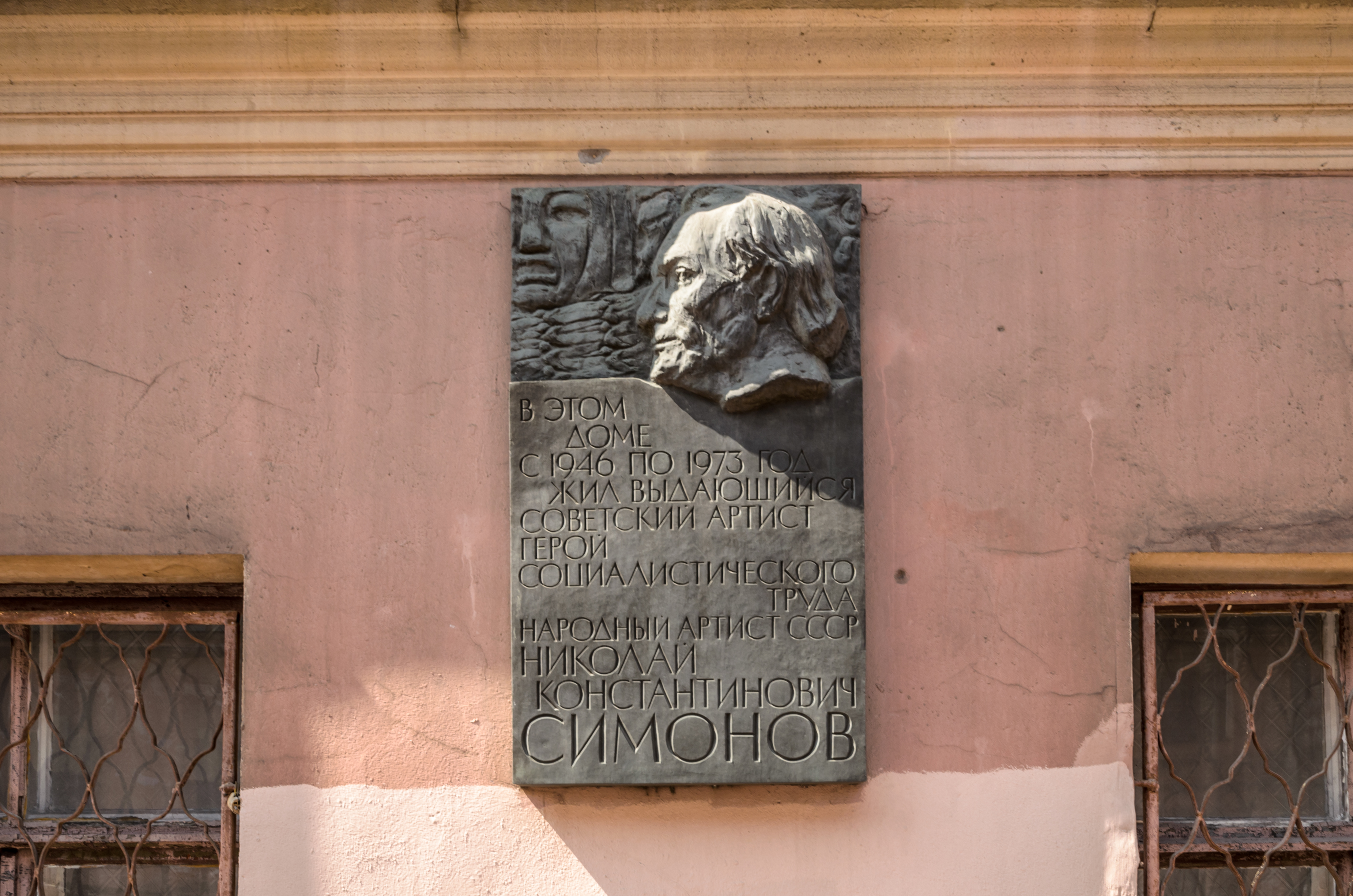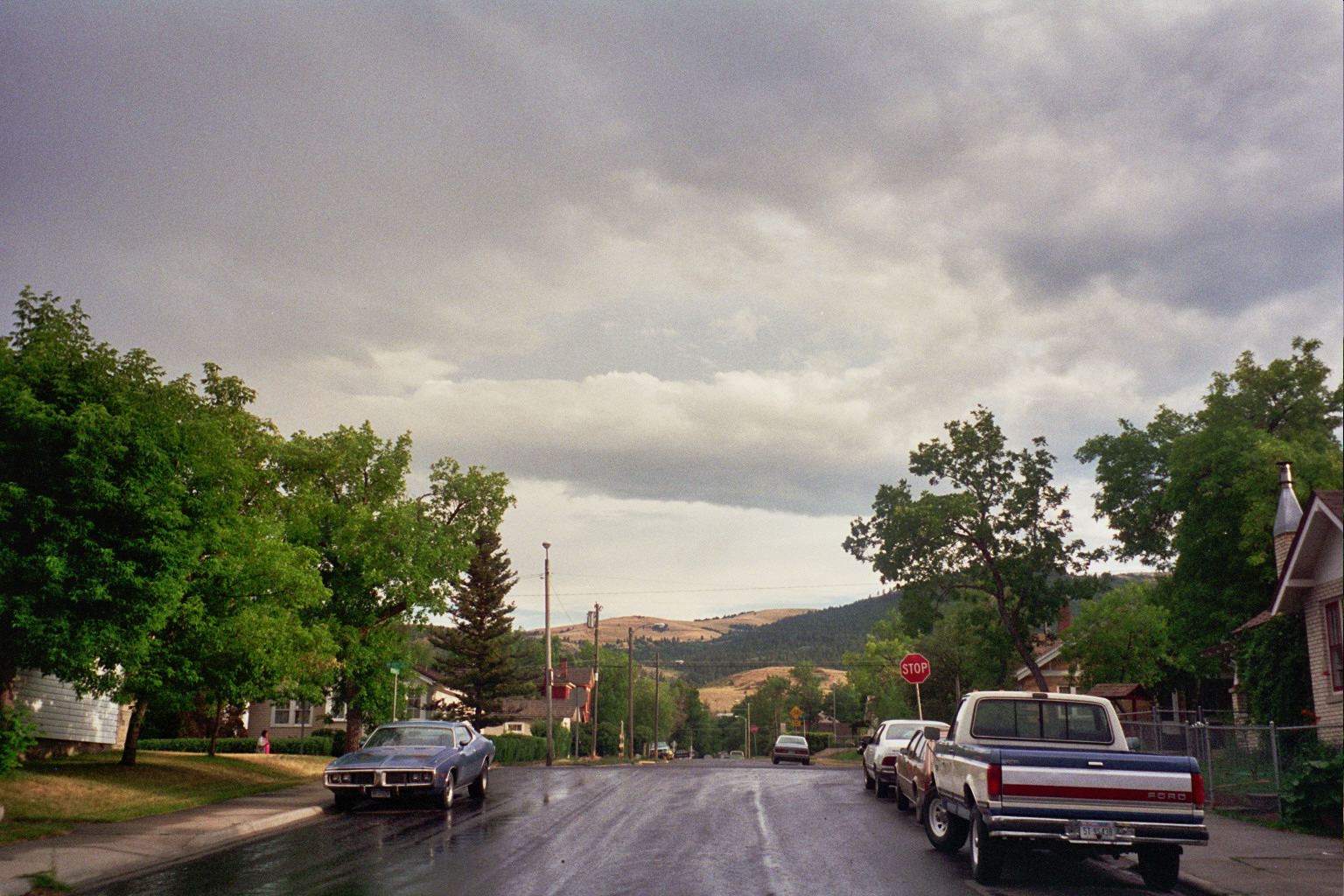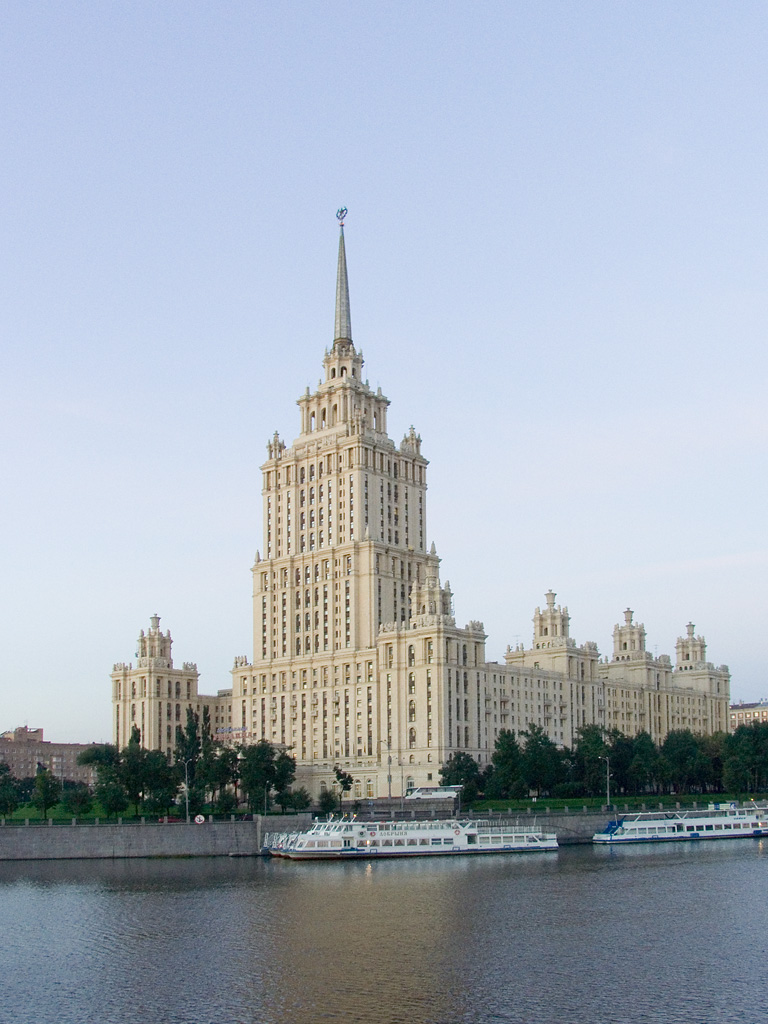|
100-flat Building
The 100-Flat Building (The Stokvartirny House, ) is an eight-floor residential building in Novosibirsk, Russia, located at Krasny Prospekt, 16. It is a historical and cultural monument of federal significance in Russia. The building was created in 1934–1937 by prominent Russian architects Andrey Kryachkov and Vitaly Maslennikov. History The building was originally conceived as a high-profile residential complex for the Soviet elite and arranged for 100 well-appointed apartments (hence the name). The initial project included 10 five-bedroom suites, 30 four-bedroom suites, 40 three-bedroom flats, and 20 two-bedroom flats. The flats have a well-designed layout, large living and utility rooms; some suites had small rooms for maids. Construction of the house began in 1934. The initial exterior design was substantially complicated in the process, for architect Maslennikov added facade elements themed after the works of French architect Auguste Perret. At the Exposition Internationa ... [...More Info...] [...Related Items...] OR: [Wikipedia] [Google] [Baidu] |
Art Deco
Art Deco, short for the French (), is a style of visual arts, architecture, and product design that first Art Deco in Paris, appeared in Paris in the 1910s just before World War I and flourished in the United States and Europe during the 1920s to early 1930s, through styling and design of the exterior and interior of anything from large structures to small objects, including clothing, fashion, and jewelry. Art Deco has influenced buildings from skyscrapers to cinemas, bridges, ocean liners, trains, cars, trucks, buses, furniture, and everyday objects, including radios and vacuum cleaners. The name Art Deco came into use after the 1925 (International Exhibition of Modern Decorative and Industrial Arts) held in Paris. It has its origin in the bold geometric forms of the Vienna Secession and Cubism. From the outset, Art Deco was influenced by the bright colors of Fauvism and the Ballets Russes, and the exoticized styles of art from Chinese art, China, Japanese art, Japan, Indian ... [...More Info...] [...Related Items...] OR: [Wikipedia] [Google] [Baidu] |
Nikolai Simonov
Nikolay Konstantionovich Simonov (; December 4, 1901 – April 20, 1973) was a USSR, Soviet film and stage actor.Театральная энциклопедия. Гл. ред. С. С. Мокульский. Т. 1 — М.: Советская энциклопедия, А — «Глобус», 1961, 1214 стб. с илл., 12 л. илл. (стб. 707) People's Artist of the USSR (1950). Biography Early life and education Nikolay Simonov was born on December 4, 1901, in Samara, Russia. From 1917–1919 he studied art at Samara School of Art and Design. From 1919–1923 he studied art at the Imperial Academy of Arts. From 1922–1924 he studied acting at the Saint Petersburg State Theatre Arts Academy, from which he graduated with honors in 1924. Career From 1924–1973, He was a permanent member with the company of Pushkin Drama Theatre in St. Petersburg. During the 1950s and 1960s he was also the theatre's artistic director. Simonov made his film debut in 1924 and played supportin ... [...More Info...] [...Related Items...] OR: [Wikipedia] [Google] [Baidu] |
Buildings And Structures In Novosibirsk
A building or edifice is an enclosed structure with a roof, walls and windows, usually standing permanently in one place, such as a house or factory. Buildings come in a variety of sizes, shapes, and functions, and have been adapted throughout history for numerous factors, from building materials available, to weather conditions, land prices, ground conditions, specific uses, prestige, and aesthetic reasons. To better understand the concept, see ''Nonbuilding structure'' for contrast. Buildings serve several societal needs – occupancy, primarily as shelter from weather, security, living space, privacy, to store belongings, and to comfortably live and work. A building as a shelter represents a physical separation of the human habitat (a place of comfort and safety) from the ''outside'' (a place that may be harsh and harmful at times). buildings have been objects or canvasses of much artistic expression. In recent years, interest in sustainable planning and building practi ... [...More Info...] [...Related Items...] OR: [Wikipedia] [Google] [Baidu] |
Tsentralny City District, Novosibirsk
Tsentralny District () is an administrative district (raion) of Central Okrug, one of the 10 raions of Novosibirsk, Russia. The area of the district is 6.4 km2 (2.5 sq mi). Population: 78 794 (2017). History Tsentralny City District was established in 1940. Streets File:Красный проспект, Новосибирск 10.jpg, Krasny Avenue File:Serebrennikovskaya Street, Novosibirsk 01.jpg, Serebrennikovskaya Street, Novosibirsk, Serebrennikovskaya Street File:Улица Депутатская (Новосибирск) 8.jpg, Deputatskaya Street, Novosibirsk, Deputatskaya Street File:Улица Фрунзе, Новосибирск 02.jpg, Frunze Street, Novosibirsk, Frunze Street File:Улица Гоголя, Новосибирск 02.jpg, Gogol Street, Novosibirsk, Gogol Street Architecture Imperial Russia File:Novosibirsk KrasnyPr Trade House 07-2016 img2.jpg, City Trade House File:Улица Потанинская 10а, Новосибирск 01.jpg File:Красны� ... [...More Info...] [...Related Items...] OR: [Wikipedia] [Google] [Baidu] |
Residential Buildings Completed In 1937
A residential area is a land used in which housing predominates, as opposed to industrial and commercial areas. Housing may vary significantly between, and through, residential areas. These include single-family housing, multi-family residential, or mobile homes. Zoning for residential use may permit some services or work opportunities or may totally exclude business and industry. It may permit high density land use or only permit low density uses. Residential zoning usually includes a smaller FAR (floor area ratio) than business, commercial or industrial/manufacturing zoning. The area may be large or small. Overview In certain residential areas, especially rural, large tracts of land may have no services whatever, such that residents seeking services must use a motor vehicle or other transportation, so the need for transportation has resulted in land development following existing or planned transport infrastructure such as rail and road. Development patterns may be regul ... [...More Info...] [...Related Items...] OR: [Wikipedia] [Google] [Baidu] |
Stanislavsky Street 7, Novosibirsk
Stanislavsky Street 7 () is a residential building in Leninsky District of Novosibirsk, Russia. It was built in 1940. Architects: V. M. Teitel, A. V. Baransky. Description Stanislavsky Street 7 is a neoclassical building on the corner of Stanislavsky and Parkhomenko streets. Gallery Улица Станиславского 7, Новосибирск 01.jpg Улица Станиславского 7, Новосибирск 02.jpg Улица Станиславского 7, Новосибирск 04.jpg See also * 100-Flat Building The 100-Flat Building (The Stokvartirny House, ) is an eight-floor residential building in Novosibirsk, Russia, located at Krasny Prospekt, 16. It is a historical and cultural monument of federal significance in Russia. The building was created i ... Bibliography * External links Stanislavsky Street 7 Жилой дом по улице Станиславского, 7. Novosibdom.ru. Leninsky District, Novosibirsk Buildings and structures in Novo ... [...More Info...] [...Related Items...] OR: [Wikipedia] [Google] [Baidu] |
Oblplan House
Oblplan House () is a residential building in neoclassical style. It is located in Tsentralny City District of Novosibirsk, Russia, on Krasny Avenue. The building was built in 1939. Architect: N. S. Kuzmin. Location The building is located on Krasny Avenue opposite Kuzbassugol Building Complex Kuzbassugol Building Complex () is a building complex located in the Tsentralny City District of Novosibirsk, Russia. It was built in 1931–1933. Architects: B. A. Gordeyev, D. A. Ageyev, B. A. Bitkin. Location The building complex is located .... Gallery Shop in Novosibirsk.jpg Notable residents * Alexander Logvinenko (1903–2000) is a Soviet scientist in the field of chemistry and technology of mineral processing. He lived in the house from 1951 to 2000. * Andrey Novikov (1909–1979) is a Soviet composer and conductor. He lived in the building from 1972 to 1979. See also * Oblpotrebsoyuz Building * House of Socialist Agriculture References Tsentralny City District, No ... [...More Info...] [...Related Items...] OR: [Wikipedia] [Google] [Baidu] |
House Of Socialist Agriculture
The House of Socialist Agriculture () is a building in Tsentralny City District of Novosibirsk, Russia. It is located between Gorky Street, Oktyabrskaya Magistral and Krasny Avenue. The building was designed by architect Nikolay Kuzmin. History The House of Socialist Agriculture was built in 1936. In 1942 Research Institute of Measuring Instruments was located here. It was evacuated to Novosibirsk. In 1952 the building was reconstructed by architect Nikolay Vasilyev. Gallery File:Октябрьская магистраль, Новосибирск 01.jpg File:Chashka Kofe, coffee shop chain 01.jpg See also * 100-Flat Building * Oblplan House Oblplan House () is a residential building in neoclassical style. It is located in Tsentralny City District of Novosibirsk, Russia, on Krasny Avenue. The building was built in 1939. Architect: N. S. Kuzmin. Location The building is located on ... References External links The House of Socialist Agriculture. NII-39. «Дом � ... [...More Info...] [...Related Items...] OR: [Wikipedia] [Google] [Baidu] |
Vasili Merkuryev
Vasili Vasilyevich Merkuryev (; 6 April 1904 – 12 May 1978) was a Soviet and Russian stage and film actor, theater director and pedagogue. People's Artist of the USSR (1960). // Krugosvet Biography Vasili Merkuryev was born into a mixed - family.[...More Info...] [...Related Items...] OR: [Wikipedia] [Google] [Baidu] |
Nikolay Konstantinovich Cherkasov
Nikolay Konstantinovich Cherkasov (14 September 1966) was a Soviet and Russian actor. He was named People's Artist of the USSR in 1947. Career He was born in Saint Petersburg (later Petrograd in 1914, and Leningrad from 1924 to 1991) into the family of a railway clerk. From 1919 he was a mime artist in Petrograd's Maryinsky Theatre, the Bolshoi Theatre, and elsewhere. After graduating from the Institute of Stage Arts in 1926, he began acting in the Young Spectator's Theatre in Leningrad. Cherkasov debuted in film with the supporting part of hairdresser Charles in Vladimir Gardin’s Pushkin biopic ''The Poet and the Tsar'' (1927). Cherkasov was one of Stalin's favorite actors and played title roles in Sergei Eisenstein's monumental sound films ''Alexander Nevsky'' (1938) and Parts I & II of ''Ivan the Terrible'' (1945 & 1946; though Part II was not officially released until 1958 because of Stalin's repression of the film). He also played Jacques Paganel in the 1936 adaptati ... [...More Info...] [...Related Items...] OR: [Wikipedia] [Google] [Baidu] |
Stalinist Architecture
Stalinist architecture (), mostly known in the former Eastern Bloc as Stalinist style or socialist classicism, is the architecture of the Soviet Union under the leadership of Joseph Stalin, between 1933 (when Boris Iofan's draft for the Palace of the Soviets was officially approved) and 1955 (when Nikita Khrushchev condemned "excesses" of the past decades and disbanded the Soviet Academy of Architecture). Stalinist architecture is associated with the Socialist realism school of art and architecture. Features As part of the Soviet policy of rationalization of the country, all cities were built to a general urban planning, development plan. Each was divided into districts, with allotments based on the city's geography. Projects would be designed for whole districts, visibly transforming a city's architectural image. The interaction of the state with the architects would prove to be one of the features of this time. The same building could be declared a Formalism (art), formalist b ... [...More Info...] [...Related Items...] OR: [Wikipedia] [Google] [Baidu] |
Yevgeny Mravinsky
Yevgeny Aleksandrovich Mravinsky () (19 January 1988) was a Soviet and Russian conductor, pianist, and music pedagogue; he was a professor at Leningrad State Conservatory. Biography Mravinsky was born in Saint Petersburg. The soprano Yevgeniya Mravina was his aunt. His father, Alexandr Konstantinovich Mravinsky, died in 1918, and in that same year, the young Mravinsky began to work backstage at the Mariinsky Theatre, serving as a ballet répétiteur from 1923 to 1931. After initially studying biology at the university in Leningrad, in 1924 he succeeded in entering the Leningrad Conservatory as a non–fee–paying student thanks to his half-aunt Alexandra Kollontai, who recommended him to the rector, Alexander Glazunov, and the commissar for enlightenment, Anatoly Lunacharsky. Mravinsky's first public conducting appearance was in 1929. Throughout the 1930s, he conducted at the Kirov Ballet and Bolshoi Opera. In September 1938, he won the All-Union Conductors Competi ... [...More Info...] [...Related Items...] OR: [Wikipedia] [Google] [Baidu] |



